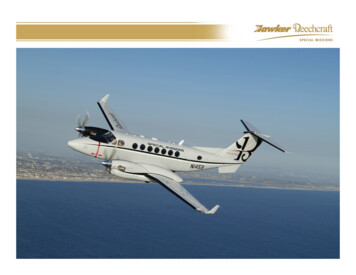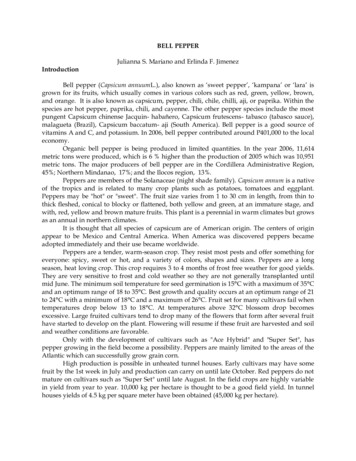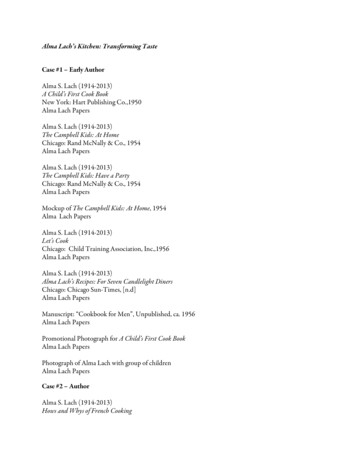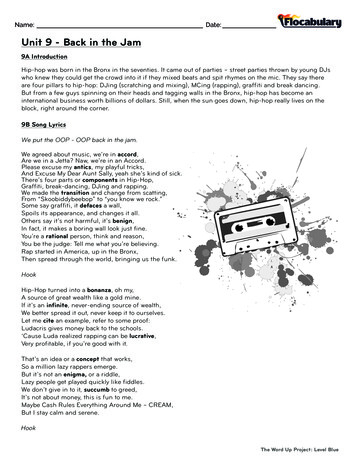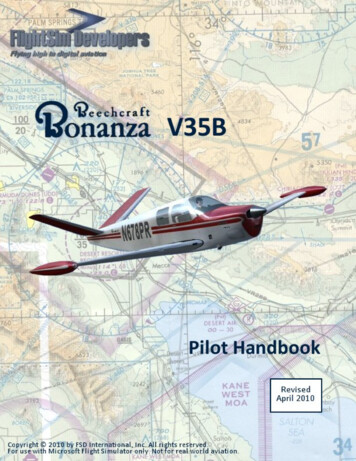
Transcription
Beechcraft V35B BonanzaPilot Operating HandbookBEECHCRAFT Bonanza V35BTHANK YOU . for displaying confidence in us by selecting our V35B Bonanza for Microsoft FlightSimulator. Our design and technical team have utilized their skills and years of experience to ensurethat the Bonanza meets the high standards of quality and performance for which FlightSim Developersairplanes have become famous throughout the world.IMPORTANT NOTICEThis handbook must be read carefully by the owner and operator in order to become familiar with theoperation of the V35B Bonanza. The handbook presents suggestions and recommendations to helpenhance your simulation experience and efficiently operate the aircraft.EULAAll rights reserved per the terms of the End User License Agreement found at the end of this manual.No part of this manual may be scanned, reproduced, copied, transmitted, distributed, downloaded orused for any purpose without the express written consent of FSD International, Inc.Information contained herein is subject to change without notice.USE OF THE HANDBOOKThe Pilot's Operating Handbook is designed to maintain documents necessary for the safe and efficientoperation of the Bonanza.- 1-
Beechcraft V35B BonanzaPilot Operating Handbook3-View Diagram- 2-
Beechcraft V35B BonanzaPilot Operating HandbookTable of ContentsBEECHCRAFT Bonanza V35B .1Section I General .5DESCRIPTIVE DATA .5ENGINE .5PROPELLER .5FUEL .5OIL CAPACITY .5WEIGHTS .5CABIN DIMENSIONS .5BAGGAGE .5Terminology And Symbols .6GENERAL AIRSPEED TERMINOLOGY .6METEOROLOGICAL TERMINOLOGY .7POWER TERMINOLOGY .7ENGINE CONTROLS AND INSTRUMENTS .7WEIGHT AND BALANCE TERMINOLOGY .8Section II Limitations . 10AIRSPEED LIMITATIONS . 10AIRSPEED INDI CATOR MARKINGS . 10POWER PLANT LIMITATIONS . 11ENGINE . 11FUEL . 11OIL. 11PROPELLER . 11POWER PLANT INSTRUMENT MARKINGS . 12WEIGHT AND CENTER OF GRAVITY . 12APPROVED MANEUVERS (2650 POUNDS) . 13FLIGHT LOAD FACTORS (2650 POUNDS) . 13REQUIRED EQUIPMENT FOR VARIOUS CONDITIONS OF FLIGHT . 13Emergency Procedures . 14EMERGENCY AIRSPEEDS . 14ENGINE FIRE (GROUND) . 14ENGINE FAILURE ON TAKE-OFF. 14ENGINE MALFUNCTION IN FLIGHT . 14ENGINE FAILURE . 14DISCREPANCY CHECKS . 14AIR START PROCEDURE . 15ENGINE FIRE (FLIGHT) . 15EMERGENCY DESCENT . 15MAXIMUM GLIDE CONFIGURATION . 16EMERGENCY LANDING. 16GEAR-UP LANDING. 16UNLATCHED DOOR IN FLIGHT . 16GENERATOR OUT PROCEDURE . 16SPINS . 16INDUCTION SYSTEM ICING . 17EMERGENCY SPEED REDUCTION . 17Normal Procedures . 18SPEEDS FOR SAFE OPERATION . 18- 3-
Beechcraft V35B BonanzaPilot Operating HandbookPREFLIGHT INSPECTION . 18BEFORE STARTING . 18STARTING . 19BEFORE TAKE-OFF . 20TAKE-OFF. 20CLIMB . 20CRUISE. 20DESCENT . 21BEFORE LANDING. 21SHUTDOWN. 21Systems Description . 22TRIM CONTROL . 22WING FLAPS . 22INSTRUMENT PANEL . 22ENGINE INSTRUMENTS. 24MANIFOLD PRESSURE GAUGE AND TACHOMETER. 24ENGINE CONTROLS. 25THROTTLE, MIXTURE AND PROPELLER. 25COWL FLAPS . 25OIL SYSTEM. 25STARTER . 26PROPELLER . 27FUEL SYSTEM . 27FUEL QUANTITY. 28FUEL TANK SELECTION . 28FUEL REQUIRED FOR FLIGHT . 29LANDING GEAR SYSTEM . 29CONTROL SWITCH . 29POSITION INDICATORS . 29WARNING HORN . 29BRAKES. 29GROUND CONTROL . 30ELECTRICAL SYSTEM. 30GENERATOR. 30LIGHTING SYSTEM. 31INTERIOR LIGHTING. 31EXTERIOR LIGHTING . 31HEATING AND VENTILATION SYSTEM CABIN HEATING. 31PITOT AND STATIC SYSTEM . 33VACUUM SYSTEM. 33STALL WARNING . 33Performance. 34INTRODUCTION TO PERFORMANCE AND FLIGHT PLANNING . 34- 4-
Beechcraft V35B BonanzaPilot Operating HandbookSection I GeneralDESCRIPTIVE DATAENGINEThe V35B Bonanza is powered by either a Continental E185-1 or E185-8 six cylinder engine rated for amaximum take-off power of 185 hp at 2300 rpm (max. one minute). The maximum continuous rating is165 hp at 2050 rpm.PROPELLERBeech electrically controlled variable pitch, two blade, 88 inch diameter propeller with Beech pitchcontrol motor and spinner. The propeller uses a Beech R203-100 hub with either R201-217-88 or R203218-88 blades.FUELAviation Gasoline 80/87 (red) minimum grade or alternate grades 100LL (blue) or 100/130 (green).Standard fuel system: Two 20-gallon tanks in wings. Total 34 gallons usable.Optional fuel system: Two 20 gallon main tanks in wings and either one 10 gallon or one 20 gallonauxiliary tank installed in the baggage compartment. All of the capacity of the 10 gallon tank is usable.The 20 gallon tank adds 19 gallons usable fuel to the system.OIL CAPACITYThe oil capacity is 10 quarts.WEIGHTSMaximum Ramp WeightMaximum Take-Off WeightMaximum Landing Weight2660 lbs2650 lbs2650 lbsCABIN DIMENSIONSLengthHeightWidthEntrance Door6 ft 11 in.4 ft 2 in,3 ft 6 in.36 in. x 37 in.BAGGAGEVolumeCapacityBaggage Door16.5 cu ft270 lbs22.5 in. x 18.5 in.- 5-
Beechcraft V35B BonanzaPilot Operating HandbookTERMINOLOGY AND SYMBOLSGENERAL AIRSPEED TERMINOLOGYCASCalibrated Airspeed is the indicated speed of an airplane, corrected for position andinstrument error. Calibrated airspeed is equal to true airspeed in standard atmosphere at sealevel.GSGround Speed is the speed of an airplane relative to the groundIASIndicated Airspeed is the speed of an airplane as shown on the airspeed indicator whencorrected for instrument error. IAS values published in this handbook assume zeroinstrument error.KCASCalibrated Airspeed expressed in "knots".KIASIndicated Airspeed exp ressed in "knots".TASTrue Airspeed is the airspeed of an airplane relative to undisturbed air which is the CAScorrected for altitude, temperature, and compressibility.VAManeuvering Speed is the maximum speed at which application of full available aerodynamiccontrol will not overstress the airplane.VFEMaximum Flap Extended Speed is the highest speed permissible with wing flaps in aprescribed extended position.VLEMaximum Landing Gear Extended Speed is the maximum speed at which an airpla ne can besafely flown with the landing gear extended.VLOMaximum Landing Gear Operating Speed is the maximum speed at which the landing gearcan be safely extended or retracted.VNENever Exceed Speed is the speed limit that may not be exceeded at any time.VNOMaximum Structural Cruising Speed is the or Vc speed that should not be exceeded except insmooth air and then only with caution.VsStalling Speed or the minimum steady flight speed at which the airplane is controllable.VSOStalling Speed or the minimum steady flight speed at which the airplane is controllable in thelanding configuration.VXBest Angle-of-Climb Speed is the airspeed which delivers the greatest gain ot altitude in theshortest possible horizontal distance.VyBest Rate-of-Climb Speed is the airspeed which delivers the greatest gain in altitude in theshortest possible time.- 6-
Beechcraft V35B BonanzaPilot Operating HandbookMETEOROLOGICAL TERMINOLOGYISAInternational Standard Atmosphere in which(1) The air is a dry perfect gas;(2) The temperature at sea level is 15 Celsius (59 Fahrenheit);(3) The pressure at sea level is 29.92 inches Hg. (1013.2 millibars);(4) The temperature gradient from sea level to the altitude at which the temperature is -56.5 C (69.7 F) is -0.00198 C (-0.003566 F) per foot and zero above that altitude.OATOutside Air Temperature is the free air static temperature obtained either from in-flighttemperature indications adjusted for instrument error and compressibility effects, or groundmeteorological sources.IndicatedPressureAltitudeThe number actually read from an altimeter when the barometric sub scale has been set to29.92 inches of mercury (1013.2 millibars).PressureAltitudeAltitude measured from standard sea-level pressure (29.92 in. Hg) by a pressure orbaro metric altimeter.StationPressureIt is the indicated pressure altitude corrected for position and instrument error. In thisHandbook, altimeter instrument errors are assumed to be zero. Position errors may beobtained from the Altimeter Correction Chart. Actual atmospheric pressure at field elevation.WindThe wind velocities recorded as variables on the charts of this handbook are to be understoodas the headwind or tailwind components of the reported winds.POWER TERMINOLOGYTake offMaximum power rating, limited by time.MaximumContinuousHighest power rating not limited by time.CruiseClimbPower recommended for cruise climb.ENGINE CONTROLS AND INSTRUMENTSThrottleUsed to control power by introducing fuel-air mixture into the intake passages of theControlengine. Settings are reflected by readings on the manifold pressure gauge.MixtureControlThis control is used to set fuel to air ratio in all modes of operationand cuts off fuel completely for engine shut down.EGTTachometerExhaust Gas Temperature Indicator. This indicator is used to identify the lean and bestpower fuel/air mixtures for various power settings.Indicates the rpm of the engine/ propeller.ADIRMIAutomatic Direction Indicator (artific ial horizon)Radio Magnetic Indicator- 7-
Beechcraft V35B BonanzaPilot Operating HandbookWEIGHT AND BALANCE TERMINOLOGYReference An imaginary vertical plane from which all horizontal distances are measured for balanceDatumpurposes.StationA location along the airplane fuselage usually given in terms of distance from the referencedatum.ArmThe horizontal distance from the reference datum to the center of gravity (C.G.) of an item.MomentThe product of the weight of an item multiplied by its arm. (Moment divided by a constant isused to simplify balance calculations by reducing the number of digits.)AirplaneCenter ofGravity(C. G.)The point at which an airplane would balance if suspended. Its distance from the referencedatum is found by dividing the total moment by the total weight of the airplane.C.G. ArmThe arm obtained by adding the airplane’s individual moments and dividing the sum by thetotal weight.C.G.LimitsThe extreme center of gravity locations within which the airplane must be operated at agiven weight.UsableFuelFuel available for flight planning.UnusableFuelFuel remaining after a runout test has been completed in accordance with governmentalregulations.StandardEmptyWeightWeight of a standard airplane including unusable fuel, full operating flu ids and full oil.BasicEmptyWeightStandard empty weight plus optional equipment.PayloadWeight of occupants, cargo and baggage.UsefulLoadMaximumRampWeightDifference between take off weight, or ramp weight if applicable, and basic empty weight.MaximumTake-offWeightMaximum weight approved for the start of the take off run.Maximum weight approved for ground maneuvering. (It includes weight of start, taxi, andrun up fuel).- 8-
Beechcraft V35B BonanzaPilot Operating HandbookMaximumLandingWeightMaximum weight approved for the landing touchdown.Zero FuelWeightWeight exclusive of usable fuel.This space left intentionally blank- 9-
Beechcraft V35B BonanzaPilot Operating HandbookSection II LimitationsThe limitations included in this section have been approved by the Federal Aviation Administration.The following limitations must be observed In the operation of this airplane.AIRSPEED LIMITATIONSCASSPEEDKNOTS176Never ExceedVNEIASMPH202KNOTS177MPH204REMARKSDo not exceed this speed inany operationMaximum StructuralCruising VNO or Vc139160140161Do not exceed this speedexcept in smooth air and thenonly with cautionManeuveringVA1131301141319110591105Do not make fullor abrupt controlmovements abovethis speedDo not extend flaps or operatewith flaps extended abovethis speed109125110127Maximum FlapExtension/ExtendedVFEMaximum LandingGear Operating!Extended VLO and VLEDo not extend, retract or operatewith landing gear extendedabove this speed except inemergencyAIRSPEED INDICATOR hite Arc49-9156-10545-9152-105Full Flap Operating RangeGreen Arc58-13967-16054- 14062-161Normal Operating RangeYellow Arc139-176160-202140-1 77161-204Operate with caution only insmooth airRed Line176202177204- 10 -Maximum speed for ALL operations
Beechcraft V35B BonanzaPilot Operating HandbookPOWER PLANT LIMITATIONSENGINEA35 Continental E 185-1 or E 185-8Take-off(one minute) 2300 rpm, Full throttleMaximum continuousoperation 2050 rpm, Full throttleB35 Continental E185-8 (S/N 51220 and above)Take-off(one minute) 2450 rpm, Full throttleMaximum continuousoperation . 2050 rpm, Full throttleNOTEOther engines are approved for this model Bonanza but notinstalled as original equipment. These are listed in the FAAAircraft Specification A-777 or approved by SupplementalType Certificate.FUELAviation Gasoline 80/87 (red) minimum grade or alternate grades 100LL (blue) or 100/130 (green). SeeEngine Manufacturer's Bulletin.OILAshless dispersant oils must meet Continental Motors Corporation Specification MHS-24A.PROPELLERBeech - two blade. 88 inch diameter (max.) propeller.- 11 -
Beechcraft V35B BonanzaPilot Operating HandbookPOWER PLANT INSTRUMENT MARKINGSOIL TEMPERATURECaution (Yellow Radial)Operating Range (Green Arc)Maximum (Red Radial)100 F/38 C100 to 225 F/38 to 107 C225 F/107 COIL PRESSUREMinimum Pressure (Red Radial)Operating Range (Green Arc)Maximum Pressure (Red Radial)30 psi30 to 60 psi80 psiTACHOMETEROperating Range (Green Arc)Cautionary Range (Yellow Arc)Maximum RPM (Red Radial)1300 to 2050 rpm2050 to 2300 rpm2300 rpmCYLINDER HEAD TEMPERATUREOperating Range (Green Arc)Maximum Temperature (Red Radial)300 to 460 Fj149 to 238 C525 F;274 CMANIFOLD PRESSUREOperating Range (Green Arc)Maximum (Red Radial)15 to 29.6 in. Hg29.6 in. HgFUEL PRESSUREMinimum (Red Radial)Operating Range (Green Arc)Maximum (Red Radial)9 psi11 to 14 psi14 psiWEIGHT AND CENTER OF GRAVITYMaximum Take-off and Landing WeightMaximum Ramp WeightZero Fuel Weight2650 lbs2660 lbsNo Structural LimitationDatum is 83.1 inches forward of center line through forward jack points.MAC leading edge is 66.7 inches aft of datum. MAC length is 65.3 inches.CG LIMITS (Gear Down)Forward:Aft:75.9 inchesvariation to85.4 inchesvariation to- 12 -aft of datum to 2140 lbs with straight line83.7 inches at 2650 lbs.aft of datum to 2405 lbs with straight line84.4 inches at 2650 lbs.
Beechcraft V35B BonanzaPilot Operating HandbookAPPROVED MANEUVERSMANEUVERChandelleSteep TurnLazy EightStall (Except Whip)(2650 POUNDS)ENTRY SPEED (CAS)113 kts/130 mph113 kts/130 mph113 kts/130 mphUse slow decelerationSpins are prohibited.FLIGHT LOAD FACTORS (2650 POUNDS)4.4G positive maneuvering load factor with flaps up. 2.0G positive maneuvering load factor with flapsdown.REQUIRED EQUIPMENT FOR VARIOUS CONDITIONS OF FLIGHTFederal Aviation Regulations (91.3(a), 91.24, 91.25, 91.32, 91.33, 91.52, 91.90, 91.97,91.170) specifythe minimum numbers and types of airplane instruments and equipment which must be installed andoperable for various kinds of flight conditions. This includes VFR day, VFR night, IFR day, and IFR night.Regulations also require that all airplanes be certificated by the manufacturer for operations undervarious flight conditions. At certification, all required equipment must be in operating condition andshould be maintained to assure continued airworthiness. If deviations from the installed equipment werenot permitted, or if the operating rules did not provide for various flight conditions, the airplane couldnot be flown unless all equipment was operable. With appropriate limitations. the operation of everysystem or component installed in the airplane is not necessary, when the remaining operativeinstruments and equipment provide for continued safe operation. Operation in accordance withlimitations established to maintain airworthiness, can permit continued or uninterrupted operation of theairplane temporarily.For the sake of brevity, the Required Equipment Listing does not include obviously required items suchas wings, rudders, flaps, engine, landing gear, etc. Also the list does not include items which do notaffect the airworthiness of the aircraft such as galley equipment, entertainment systems, passengerconvenience items, etc. However, it is important to note that ALL ITEMS WHICH ARE RELATED TO THEAIRWORTHINESS OF THE AIRPLANE AND NOT INCLUDED ON THE LIST ARE AUTOMATICALLY REQUIREDTO BE OPERATIVE.To enable the pilot to rapidly determine the FAA equipment requirements necessary for a flight intospecific conditions, the following equipment requirements and exceptions are presented. It is the finalresponsibility of the pilot to determine whether the lack of, or inoperative status of a piece of equipmenton his airplane, will limit the conditions under which he may operate the airplane.NOTEFLIGHT IN KNOWN ICING CONDITIONS PROHIBITED.- 13 -
Beechcraft V35B BonanzaPilot Operating HandbookEmergency ProceduresEMERGENCY AIRSPEEDSEmergency DescentGlideEmergency LandingApproach110 kts/127 mph105 kts/121 mph70-76 kts/81-87 mphAll airspeeds quoted in this section are indicated airspeeds (IAS).The following information is presented to enable the pilot to form, in advance, a definite plan of actionfor coping with the most probable emergency situations which could occur in the operation of theairplane. Where practicable, the emergencies requiring immediate corrective action are treated in checklist form for easy reference and familiarization. Other situations, in which more time is usually permittedto decide on and execute a plan of action, are discussed at some length.ENGINE FIRE (GROUND)1.Mixture - IDLE CUT -OFF2.Fuel Selector Valve - OFF3.Battery, Generator and Ignition Switches - OFF4.Extinguish with Fire Extinguisher.ENGINE FAILURE ON TAKE-OFFDURING GROUND ROLL1.Throttle - CLOSED2.Braking - MAXIMUM3.Fuel Selector Valve - OFF4.Battery and Generator Switches - OFFIf airborne and insufficient runway remains for landing:1.Fuel Selector Valve - SELECT OTHER MAIN TANK2.Auxiliary (Wobble) Fuel Pump - PUMP (9 TO 10 P.S.I.)3.Mixture - FULL RICH4.Ignition - CHECK, ON BOTHIF NO RESTART1.Select most favorable landing site.2.See EMERGENCY LANDING procedure.3.The use of landing gear is dependent on the terrain where landing must be made.ENGINE MALFUNCTION IN FLIGHTENGINE FAILUREThe most probable cause of engine failure would be loss of fuel flow or improper functioning of theignition system.DISCREPANCY CHECKS(Rough running engine, loss of engine power, loss of fuel flow, etc.)1.Rough Running Enginea. Mixture - FULL RICH, then lean as requiredb. Ignition Switch - CHECK on BOTH position- 14 -
Beechcraft V35B BonanzaPilot Operating Handbook2.Loss of Powera. Fuel Pressure Gage - CHECK (fuel pressure abnormally low)(1) Mixture - FULL RICH(2) Auxiliary (Wobble) Fuel Pump - MAINTAIN FUEL PRESSURE(3) Auxiliary (Wobble) Fuel Pump - STOP if performance does not improve in a few momentsb. Fuel Quantity Indicator - CHECK (fuel tank being used is empty)(1) Select other tank (check to feel detent)c. Carburetor Heat - Pull full carburetor heat and check for manifold pressure drop. Pushcarburetor heat to cold position - manifold pressure should return to original position.Propeller OverspeedRetard throttle to reduce RPM to red line.Propeller switch to manual LO RPM.Reduce speed to assist in maintaining altitude.Select nearest landing site, follow emergency landing procedures.3.a.b.c.d.AIR START PROCEDUREa.Mixture - IDLE CUT -OFFb.Fuel Selector Valve - OFF to clear engine then TO MAIN TANK MORE NEARLYFULLNOTEIf the failure was due to the fuel metering valve sticking in the full open position, the carburetor willdeliver an excess of fuel, with constant flooding. Shutting off fuel momentarily will clear the engine andmay restore normal operation by allowing the spring in the carburetor to reseat the valve.c.d.e.f.Throttle - 1/4 INCH OPENMixture - FULL RICHAuxiliary (Wobble) Fuel Pump - MAINTAIN FUEL PRESSUREThrottle - ADVANCE to desired powerENGINE FIRE (FLIGHT)The red VENT SHUTOFF control on the outboard side of the right lower subpanel is used to close off allheating system outlets so that smoke and fumes will not enter the cabin. In the event of engine fire,shut down the engine as follows and make a landing:1.2.3.4.5.Vent Shutoff Control - PULL TO CLOSEMixture - IDLE CUT -OFFFuel Selector Valve - OFFBattery, Generator, and Ignition Switches - OFF (Extending the landing gear can beaccomplished manually if desired.)Do not attempt to restart engine.EMERGENCY DESCENT1.2.3.4.Power - IDLEPropeller - HI RPMLanding Gear - DOWNAirspeed - ESTABLISH 110 kts/127 mph- 15 -
Beechcraft V35B BonanzaPilot Operating HandbookMAXIMUM GLIDE CONFIGURATION1.2.3.4.5.Landing Gear - UPFlaps - UPCowl Flaps - CLOSEDPropeller - LO RPMAirspeed - 105 kts/121 mphGlide distance is approximately 1.7 nautical miles (2 statute miles) per 1000 feet of altitude above theterrain.EMERGENCY LANDINGWhen assured of reaching the landing site selected, and on final approach:1.2.3.4.5.6.Airspeed - Establish 70 to 76 kts;81 to 87 mphFuel Selector Valve - OFFM
Limits The extreme center of gravity locations within which the airplane must be operated at a given weight. Usable Fuel Fuel available for flight planning. . Zero Fuel Weight Weight exclusive of usable fuel. This space left intentionally blank . Beechcraft V35B Bonanza Pilot Oper ating Handbook
